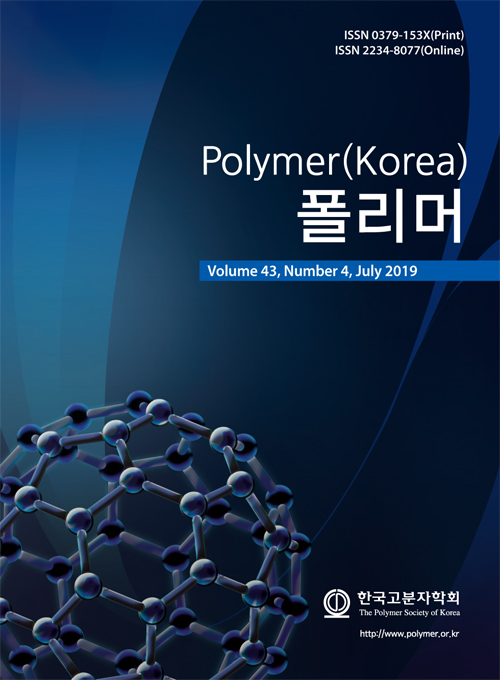- Preparation and Properties of Thiol-ene UV-cured Nanocomposites with Methacrylate-grafted Cellulose Nanocrystals as Fillers
Department of Chemical Engineering, Keimyung University, Daegu 42601, Korea
- 메타크릴레이트기가 접목된 셀룰로오스 나노결정 충전제를 이용한 Thiol-ene 자외선 경화 나노복합체 제조 및 물성에 대한 연구
계명대학교 공과대학 화학공학과
In this study, we grafted free radical polymerizable methacrylate groups on the surface of cellulose nanocrystals (CNCs) using 3-methacryloxypropyltrimethoxysilane (MPTMS) as a silane coupling agent. We prepared nanocomposites using pristine CNCs and MPTMS modified CNCs (MPTMS-CNCs) as fillers in UV-curable resin by thiol-ene step-growth photopolymerization. The effects of pristine CNC and MPTMS-CNC fillers on thermal stability, tensile strength, elastic modulus, and dispersion state of fillers in nanocomposites were measured by Fourier transform infrared spectrometer (FTIR), thermogravimetric analyzer (TGA), universal testing machine (UTM), dynamic mechanical analyzer (DMA), and field emission scanning electron microscope (FE-SEM). The MPTMS-CNC filler was more effective in increasing tensile strength and elastic modulus of nanocomposites than CNC.
본 연구에서는 3-methacryloxypropyltrimethoxysilane(MPTMS) 실란 커플링제를 사용하여 자유 라디칼 중합이 가능한 메타크릴레이트(methacrylate)기를 셀룰로오스 나노결정(cellulose nanocrystal, CNC) 표면에 도입하였다. 위 MPTMS로 개질된 CNC(MPTMS-CNC)를 충전제로 사용하여 자외선 경화가 가능한 수지를 사용하여 thiol-ene 단계 성장 광중합법으로 나노복합체를 제조하는 연구를 수행하였다. 순수 CNC 및 MPTMS-CNC 충전제들이 나노복합체의 열안정성, 인장강도 및 탄성률 등 물성에 미치는 영향을 푸리에 변환 적외선 분광기(FTIR), 열중량분석기(TGA), 만능재료시험기(UTM), 동적기계적분석기(DMA) 및 주사전자현미경(FE-SEM)을 사용하여 분석하였다. MPTMS-CNC 충전제는 CNC보다 나노복합체의 인장강도와 탄성률을 더 많이 증가시키는 것을 확인하였다.
Keywords: cellulose nanocrystal, 3-methacryloxypropyltrimethoxysilane, surface modification, UV-curing, mechanical property
- Polymer(Korea) 폴리머
- Frequency : Bimonthly(odd)
ISSN 0379-153X(Print)
ISSN 2234-8077(Online)
Abbr. Polym. Korea - 2023 Impact Factor : 0.4
- Indexed in SCIE
 This Article
This Article
-
2019; 43(4): 612-620
Published online Jul 25, 2019
- 10.7317/pk.2019.43.4.612
- Received on Mar 26, 2019
- Revised on May 24, 2019
- Accepted on May 25, 2019
 Correspondence to
Correspondence to
- KiRyong Ha
-
Department of Chemical Engineering, Keimyung University, Daegu 42601, Korea
- E-mail: ryongi@kmu.ac.kr









 Copyright(c) The Polymer Society of Korea. All right reserved.
Copyright(c) The Polymer Society of Korea. All right reserved.